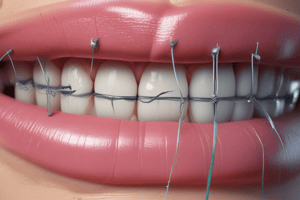Podcast
Questions and Answers
What type of suture material is Plain Gut?
What type of suture material is Plain Gut?
- Non-absorbable
- Absorbable (correct)
- Natural (correct)
- Synthetic
What color is Chromic Gut?
What color is Chromic Gut?
- Brown (correct)
- Coral
- Yellow
- Purple
What type of suture is Vicryl?
What type of suture is Vicryl?
- Synthetic (correct)
- Natural
- Multi filament (correct)
- Mono filament
What is the primary characteristic of Monocryl?
What is the primary characteristic of Monocryl?
What is the color of PDS suture material?
What is the color of PDS suture material?
What material is Dexon made from?
What material is Dexon made from?
What color is Silk suture material?
What color is Silk suture material?
What type of suture is Nylon?
What type of suture is Nylon?
What color is Ticron/Ethibond suture material?
What color is Ticron/Ethibond suture material?
Match the following suture types with their properties:
Match the following suture types with their properties:
What is a suture?
What is a suture?
What is a ligature?
What is a ligature?
What is the purpose of needles in suturing?
What is the purpose of needles in suturing?
What is the difference between a suture and a suture ligature?
What is the difference between a suture and a suture ligature?
A strand of suture passed by itself is called a ______.
A strand of suture passed by itself is called a ______.
A strand of suture attached to a right angle clamp is called a ______.
A strand of suture attached to a right angle clamp is called a ______.
Flashcards are hidden until you start studying
Study Notes
Suture Material Types
- Plain Gut: Absorbable, monofilament, natural; color is yellow.
- Chromic Gut: Absorbable, monofilament, natural; color is brown.
- Vicryl: Absorbable, multifilament, synthetic; color is purple, made of Polyglactin 910.
- Monocryl: Absorbable, monofilament, synthetic; color is coral, made of Polyglecaprone.
- PDS: Absorbable, monofilament, synthetic; color is silver.
- Dexon: Absorbable, multifilament, synthetic; color is gold, made of Polyglycolic Acid.
- Silk: Non-absorbable, multifilament, natural; color is light blue.
- Cotton: Non-absorbable, multifilament, natural; color is pink.
- Nylon: Non-absorbable, monofilament, synthetic; color is green.
- Ticron/Ethibond: Non-absorbable, multifilament, synthetic; color is orange.
- Mersilene: Non-absorbable, multifilament, synthetic; color is turquoise.
- Surgical Steel: Non-absorbable, monofilament, synthetic; color is yellow ochre.
- Prolene: Non-absorbable, monofilament, synthetic; color is dark blue.
Suture Classification
- Monofilament: Consists of a single thread, does not harbor bacteria, and glides easily through tissue.
- Multi-filament: Composed of more than one thread, twisted or braided; it holds knots securely but can harbor bacteria.
Advantages and Disadvantages
- Monofilament Advantages: Does not harbor bacteria and allows for easy gliding through tissue.
- Monofilament Disadvantages: Holds knots poorly and can be difficult to handle.
- Multi-filament Advantages: Secures knots effectively and is easier to handle.
- Multi-filament Disadvantages: Prone to harboring bacteria.
Key Terms
- Sutures: Used to approximate tissue and support the healing process.
- Needles: Essential for inserting suture material into tissue; must be strong and available in various sizes and shapes.
- Ligature: A strand of material for approximating tissue.
- Suture Ligature: A strand of suture with an attached needle; used to prevent bleeding or tie off blood vessels.
- Free Tie: A strand of suture passed by itself.
- Tie on a Passer: A strand of suture attached to a right angle clamp for ease of handling.
Studying That Suits You
Use AI to generate personalized quizzes and flashcards to suit your learning preferences.




